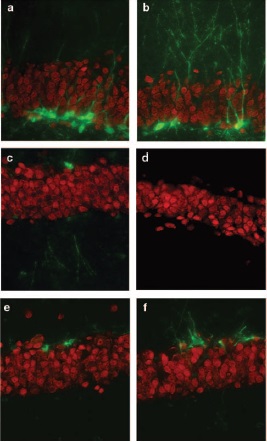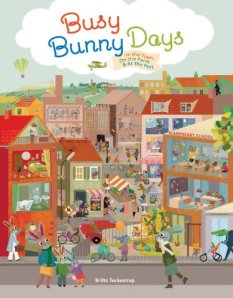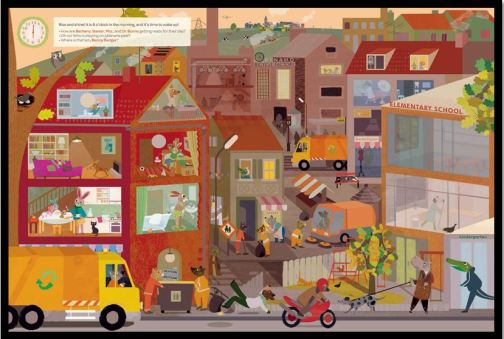By Gary Wenk
Marijuana is the leafy material from Cannabis indica plant that is generally smoked. By weight, it typically contains 2%-5% delta-9 tetrahydrocannabinol (THC), the primary psychoactive agent. However the plant also contains about fifty other cannabinoid-based compounds, including cannabidiol (CBD).
One Internet ad claims that “cannabidiol (CBD) can cure arthritis, multiple sclerosis, chronic pain, schizophrenia, and epilepsy.” CBD is the main non-psychotropic cannabinoid present in the Cannabis sativa plant, constituting up to 40% of its extract. Somehow this one particular component of the marijuana plant has become much more popular than all of the sixty (at least) other biologically active molecules that have been isolated from this plant, to the point where growers are breeding marijuana plants with significantly higher levels of CBD.

Why are people so excited about CBD? The answer lies in unpacking a series of complex truths, making distinctions between what is known and what is not known, and dispelling some false claims.
The human brain naturally possesses a pair of protein receptors that respond to endogenous marijuana-like chemicals. These receptors are incredibly common and are found throughout the human brain. When a person smokes marijuana, all of the various chemicals in the plant are inhaled, ultimately, into the brain where they find and bind to these receptors, similar to a key fitting into a lock. Which receptors are affected, and what parts of the brain are involved, differs for just about everyone, depending upon their genetic make-up, drug-taking history, and expectations regarding the experience; the last factor being commonly known as the placebo effect.

The images above come from Dr. Wenk’s research at Ohio State University, and demonstrate an increase in hippocampus neuron activity in rats following a cannabinoid treatment.
In addition, the chemicals inhaled into the brain also interact with a complex array of other neural systems; these interactions also contribute to the overall psychoactive experience, such as the marijuana’s ability to reduce anxiety, produce euphoria, or induce “the munchies.” My own research has demonstrated the positive effects of stimulation of the endogenous cannabinoid neural system in the aging brain.
Both CBD and THC are capable of interacting with this complex variety of proteins. However, and this is where things get interesting, they do not do so with the same degree of effectiveness. Scientists have shown that THC is over one thousand times more potent than is CBD, meaning a person would need to consume 1,000 “joints” of the genetically modified CDB-marijuana plant to get high. This chemical property of CBD has led to the accurate claim that CBD does not make one feel “high.” However, the low potency of CBD may also indicate that, by itself, it offers limited clinical benefits – currently- no one knows. Animal studies have discovered many beneficial effects of CBD but only when administered at very high doses.
What has become quite apparent is that no single component of the plant is entirely good or bad, therapeutic or harmful, or deserving of our complete attention. To date, all of the positive evidence supporting the use of medical marijuana in humans has come from studies of the entire plant or experimental investigations of THC. Given the very low potency of CBD within the brain it is highly unlikely that CBD alone will provide significant clinical benefit. Some small clinical trials are being initiated; until rigorous scientific studies are completed no one can claim that CBD is better than THC.
Gary L. Wenk, PhD., a Professor of Psychology & Neuroscience & Molecular Virology, Immunology and Medical Genetics at the Ohio State University and Medical Center, is a leading authority on the consequences of chronic brain inflammation and animal models of Alzheimer’s disease. He is also the author of Your Brain on Food: How Chemicals Control Your Thoughts and Feelings.
Subscribe to the OUPblog via email or RSS.
Subscribe to only health and medicine articles on the OUPblog via email or RSS.
Image Credit: First image is from United States Fish and Wildlife Service. Public Domain via Wikimedia Commons.
The post Is CBD better than THC?: exploring compounds in marijuana appeared first on OUPblog.

 .
.
Busy Bunny Days: In the Town, On the Farm & At the Port
by Britta Teckentrup
Chronicle Books* 2/25/2014
978-1-4521-1700-3
Age 4 – 8 56 pages
.
Back Cover
“What is the Bunny Family doing today? Join the bunny family for a busy day in their hometown, on a fun-filled farm adventure, and at the port for an exciting outing! From the time they wake up until the time they go to sleep, there is so much to see and do. Don’t forget to keep an eye out for that pesky Benny Badger—he is always up to no good!”
Opening
“IN THE TOWN . . . Join the Bunny family for a busy day in their hometown, surrounded by friends and neighbors!”
The Story
The Bunny family—Baxter, Bethany, Mom, Dad (doctor) and Grandma Bunny—are spending the day in their hometown. There is so much to see, many other bunnies to visit, and others to greet, “Hi!” Everyone rises for the new day, dressing, eating, and opening his or her shiny, wide eyes. Outside the street is very busy. Harold Hippo is walking his pooch, Gary Gator is jogging, and—Oh, No!—Barbara Bear slips on a banana peel. 9 AM and school is ready to begin. Bethany enters kindergarten after her dad walked her to school. Baxter is on the playground with his friend Vincent, a tiger. At home, mom is feeding the two cats and grandma is knitting. Such a busy start to the day.
At 12 noon, it starts to rain. Benny Badger is leaving the bakery. What is he up to now? Grandma is on her way home with two sacks of groceries. Bethany is in a line with her classmates and Baxter is still in class. Uh, oh, a cat is on the table. Where is mom to scold the cat? 3 PM is snack time. Grandma Bunny is bringing Bethany a drink—the cat is on the floor. Baxter is learning math with his teacher, Mrs. Katz. Barbara Bear is walking down the street, aided by a crutch for her broken and casted leg. Benny Badger is a pickpocket! He is stealing Bernhard Builder’s wallet right out of his back pocket. 9 PM is time for everyone to sleep. The day was interesting. The fire department put out a fire in the apartment above the Bunny’s apartment four hours ago. Benny Badger broke into someone’s car and into the bakery. Now, at nine at night, Bethany and Baxter are asleep. The town gets quiet and the police arrest Benny Badger. Tomorrow the Bunny Family will go to the farm and the day after to the port. But wtch out! Benny Badger will be there too.
Review
Busy Bunny Days: In the Town, on the Farm, and at the Port will keep kids busy. Originally three books, each book divided by hour segments. 6 AM starts the day, which continues at spaced intervals until bedtime and the end of the day at 9 PM. The spreads are busy with loads of activity by many anthropomorphic creatures. Before each story begins, a page of the story’s characters, illustrated and named, make finding them much easier. I found myself referring to this page many times. At the top of each spread are questions for the reader.
“Who is awake?” / “What is Mrs. Bunny doing?” / “Has Squawk made a friend?”

Benny Badger is the bad badger in every story and it is always a good idea to keep track of what this scoundrel is doing. Busy Bunny Days: In the Town represents a normal day for the Bunny Family. Bethany and Baxter go to school, Dr. Bunny goes to work, and Mrs. Bunny and Grandma Bunny do all sorts of things. The creatures around the town are actually more fascinating than the Bunny Family.
Busy Bunny Days: On the Farm, the Bunny Family is visiting friends, the Gardiners, who own a farm. Interestingly, in addition to the anthropomorphic animals, there are regular animals: cows, chickens, horses, pigs, dogs. Once again, Benny Badger is around to create havoc. The farm slower paced looks more like a tourist attraction than a working farm.

Busy Bunny Days: at the Port, is the third book in this three-book compilation, all originally published in Germany in 2011 and 2012. The port is a very busy place, and Benny Badger is there to cause trouble. I think he follows the Bunny Family, just as we are doing. Docked at the port are several ships, including a pirate ship and the Poseidon, still afloat and unloading its cargo containers. Baxter is sporting an eye patch and wielding a dagger. At the Port is the best of the three books.
The illustrations are bright, cheery, and simply fun. Each spread holds more than the eye can comprehend in one look. Kids will have so much to look for and follow throughout the day. There are more to follow from spread to spread than just the Bunny Family. Barbara Bear slips on a banana peel, breaks her leg, and returns on a crutch. Harold Hippo cannot keep a hold of his dog’s leash, the dog runs, and finds its way to the school where Baxter pets the happy mutt. On the farm, Late at night—seven o’clock—everyone dances.

If your child likes to find things in the illustrations, then Busy Bunny Days will keep them busy for a long time. Without an actual text, kids can make up stories for their favorite character. Parents can read the questions at the top of each spread, helping their child with the answers. After that, kids can master Busy Bunny Days on their own, changing the story as they please. Busy Bunny Days: In the Town, on the Farm, and at the Port will entertain your child while growing their imagination as they story each character in their own way, finding and following the Bunny Family and their friends and neighbors—and Benny Badger, too!
.
Learn more about Busy Bunny Days: In the Town, on the Farm, and at the Port HERE.
Buy Busy Bunny Days: In the Town, on the Farm, and at the Port at Amazon —B&N—Chronicle Books—at your local bookstore.
—B&N—Chronicle Books—at your local bookstore.
.
Find the author/illustrator, Britta Teckentrup at: website unitedartists nosy crow
Find more great books at Chronicle Books at: website blog** facebook twitter
**HAVE A GREAT IDEA FOR A FUNNY BOOK? NOW IS THE TIME: THE GREAT TUMBLR BOOK SEARCH SEE BLOG POST ABOVE
.
BUSY BUNNY DAYS: IN THE TOWN, ON THE FAR, AT THE PORT. Text and illustrations copyright © 20111, 2012 by Britta Teckentrup. Reproduced by permission of the publisher, Chronicle Books, San Francisco, CA.
.
*Originally published in Germany in 2011 and 2012 by Veriagshaus Jacoby & Stuart GmbH, Berlin, Germany. *Original titles: Das 24-Stunden-Wimmelbuch: In der Stadt ist was los!, Das 24-Stunden-Wimmelbuch: Auf dem Bauernhof ist!, Das 24-Stunden-Wimmelbuch: Am Hafen ist was los! *Translated by Chronicle Books, 2014.
.
.

Filed under:
5stars,
Children's Books,
Favorites,
Library Donated Books,
Picture Book Tagged:
Britta Teckentrup,
bunnies,
children's book reviews,
children's picture books,
Chronicle Books,
farm,
neighborhood,
pot 







By Marcello Pennacchio
Few plants have generated as much debate and controversy as cannabis (Cannabis sativa). Throughout the ages, it has been labelled both a dangerous drug and potent medicine. Where the former is concerned, law-enforcement agents and governments spend millions of dollars fighting what many consider to be a losing battle, while fortunes are being pocketed by those who sell it illegally. This is in spite of the fact that cannabis produces a number of natural pharmacologically-active substances, the medicinal potential of which were recognized thousands of years ago. Chinese Emperor, Shên Nung, for example, prescribed cannabis elixirs for a variety of illnesses as early as 3000 BC. It was equally prized as a medicine in other ancient civilisations, including India, Egypt, Assyria, Palestine, Judea and Rome and may have been instrumental in helping Ancient Greece’s Delphian Oracle during her divinations.
While its more common contemporary uses are mostly recreational, cannabis continues to enjoy widespread use as a medicine. It is smoked to ease glaucoma, to help with the degenerative loss of condition and body mass associated with diseases such as HIV/AIDS, and it helps to ease chronic pain in people suffering from terminal cancers and other debilitating illnesses. It has been used for treating malaria, gout, multiple sclerosis, eating disorders, promoting euphoria, as well as for dispelling grief and sorrow. A number of serious side effects have also been linked to its use, however. These include heart problems, immune system suppression, cancer, depression, reduced cognitive function and poor fetal development. It can lead to a variety of psychological problems, too, such as psychosis and schizophrenia, as well as to addiction to this and other drugs. Then there is the added danger of inhaling dangerous chemicals generated during the combustion of organic matter. Chief among these are carbon monoxide and polycyclic aromatic hydrocarbons.
With so many pros and cons, it’s easy to see why the issue of cannabis has so significantly polarized sentiment around the world. Those in favour of its use want it legalized, with perhaps its most vocal advocates being in San Francisco. This is where one of the world’s first universities dedicated solely to cannabis, is located. Founded in 2007 by Richard Lee, Oaksterdam University was inspired by a similar college in Amsterdam and has since spread to include campuses elsewhere in California and in Michigan. So passionate are its founders and students about cannabis that they have taken the debate of legalizing it all the way to California’s November 2, 2010, ballot, a move that has since made world headlines. Many had hoped a similar proposal in Florida, known as the Medical Marijuana Initiative, would have made it into that state’s ballot, too, but the petition failed to gather the 700, 000 signatures required for it to qualify. Florida’s four-year rolling petition system means, however, that it may qualify for the 2012 ballot.
Surprisingly, the push to legalize cannabis includes former judges, politicians and other high-profile people, many of who themselves don’t use cannabis (including this author). They believe that penalizing and incarcerating its users is far more detrimental to them than smoking its parts are. They further contend that legalizing and taxing cannabis would raise significant revenue for governments. It would also alleviate the enormous drain of cash reserves needed to police its illegal use and, in the process, eliminate the criminal syndicates that sell it. Furthermore, they claim it would ensure that the quality of the product meets stringent regulations.
These are all convincing arguments, but it is difficult for many of us to get around the fact that smoking cannabis, a
I have set a new record! Latest-in-the-day Linked Up ever!
(I think I need some new personal goals…so if anyone has recommendations…)
5-year-old Aidan is amazing. But he has leukemia and is selling his art to help pay for treatment. Buy his art on Etsy. [tip from SirMitchell]
Are any of you fans of “The Room?” If so, you’re welcome. [The Daily What]
I wish there was a way to make drinking coffee even easier OH WAIT THERE IS! [Yanko]
This cartoon is just…amazing. [New Yorker]
I love stop-motion film. I love Lite-Brites. So. This. [Flavorwire]
Will Smith’s daughter has a recommendation for you. Careful, this will be stuck in your head for days. [Willow]
Snakes on a plane? How ’bout a crocodile? [News AU]
Shameless self-promotional plug of the week…
Dear friends from middle-school, I will probably be buying these shoes and you can’t stop me. [hypebeast]
I just discovered that there is a University dedicated to providing “the highest quality training for the cannabis industry.” So, more on that Monday… [Oaksterdam]











